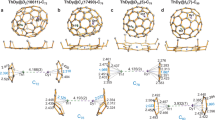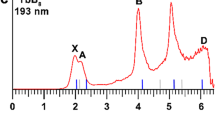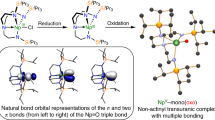Abstract
The participation of the valence orbitals of actinides in bonding has been debated for decades. Recent experimental and computational investigations demonstrated the involvement of 6p, 6d and/or 5f orbitals in bonding. However, structural and spectroscopic data, as well as theory, indicate a decrease in covalency across the actinide series, and the evidence points to highly ionic, lanthanide-like bonding for late actinides. Here we show that chemical differentiation between californium and lanthanides can be achieved by using ligands that are both highly polarizable and substantially rearrange on complexation. A ligand that suits both of these desired properties is polyborate. We demonstrate that the 5f, 6d and 7p orbitals are all involved in bonding in a Cf(III) borate, and that large crystal-field effects are present. Synthetic, structural and spectroscopic data are complemented by quantum mechanical calculations to support these observations.
This is a preview of subscription content, access via your institution
Access options
Subscribe to this journal
Receive 12 print issues and online access
$259.00 per year
only $21.58 per issue
Buy this article
- Purchase on Springer Link
- Instant access to full article PDF
Prices may be subject to local taxes which are calculated during checkout




Similar content being viewed by others
References
Sykora, R. E., Assefa, Z., Haire, R. G. & Albrecht-Schmitt, T. E. The first structural determination of a trivalent californium compound with oxygen coordination. Inorg. Chem. 45, 475–477 (2006).
Burns, J. H., Peterson, J. R. & Baybarz, R. D. Hexagonal and orthorhombic crystal structures of californium trichloride. J. Inorg. Nucl. Chem. 35, 1171–1177 (1973).
Laubereau, P. G. & Burns, J. H. Microchemical preparation of tricyclopentadienyl compounds of berkelium, californium, and some lanthanide elements. Inorg. Chem. 9, 1091–1095 (1970).
Galbis, E. et al. Solving the hydration structure of the heaviest actinide aqua ion known: the californium(III) case. Angew. Chem. Int. Ed. 49, 3811–3815 (2010).
Lindqvist-Reis, P. et al. The structures and optical spectra of hydrated transplutonium ions in the solid state and solution. Angew. Chem. Int. Ed. 46, 919–922 (2007).
Apostolidis, C. et al. [An(H2O)9][CF3SO3]3 (An=U–Cm, Cf): Exploring their stability, structural chemistry, and magnetic behavior by experiment and theory. Angew. Chem. Int. Ed. 49, 6343–6347 (2010).
Skanthakumar, S. Antonio, M. R., Wilson, R. E. & Soderholm, L. The curium aqua ion. Inorg. Chem. 46, 3485–3491 (2007).
Kaltsoyannis, N. Does covalency increase or decrease across the actinide series? Implications for minor actinide partitioning. Inorg. Chem. 52, 3407–3413 (2013).
Neidig, M. L., Clark, D. L. & Martin, R. L. Covalency in f-element complexes. Coord. Chem. Rev. 257, 394–406 (2013).
Polinski, M. J. et al. Differentiating between trivalent lanthanides and actinides. J. Am. Chem. Soc. 134, 10682–10692 (2012).
Ruiz-Martínez, A., Casanova, D. & Alverz, S. Polyhedral structures with an odd number of vertices: nine-coordinate metal compounds. Chem. Eur. J. 14, 1291–1303 (2008).
Ruiz-Martínez, A. & Alverz, S. Stereochemistry of compounds with coordination number ten. Chem. Eur. J. 15, 7470–7480 (2009).
Li, L. et al. Synthesis of rare earth polyborates using molten boric acid as a flux. Chem. Mater. 14, 4963–4968 (2002).
Castro-Rodriguez, I. et al. Uranium tri-aryloxide derivatives supported by triazacyclononane: engendering a reactive uranium(III) center with a single pocket for reactivity. J. Am. Chem. Soc. 125, 4565–4571 (2003)
Skanthakumar, S., Soderholm, L. & Movshovich, R. Magnetic properties of Dy in Pb2Sr2DyCu3O8 . J. Alloy Compd. 303, 298–302 (2000).
Staub, U. et al. Valence determination as a function of doping in PrBa2Cu3O7- δ . Phys. Rev. B. 61, 1548 (2000).
Fields, P. R., Wybourne, B. G. & Carnall, W. T. The Electronic Energy Levels of the Heavy Actinides Bk 3+(5f 8), Cf 3+(5f 9), Es 3+(5f 10), and Fm3+(5f 11) Report ANL-6911 (Argonne National Laboratory AEC Research and Development, US Atomic Energy Commission, 1964).
Campos, A. F., Meijerink, A., de Mellow Donegá, C. & Malta, O. L. A theoretical calculation of vibronic coupling strength: the trend in the lanthanide ion series and the host-lattice dependence. J. Phys. Chem. Solids 61, 1489–1498 (2000).
Legendziewicz, J. Spectroscopy and structure of selected lanthanide polymeric and monomeric systems. J. Alloy Compd. 300, 71–87 (2000).
Perdew, J. P., Ernzerhof, M. & Burke, K. Rationale for mixing exact exchange with density functional approximations. J. Chem. Phys. 119, 9982–9985 (1996).
Perdew, J. P., Burke, V. & Ernzerhof, M. Generalized gradient approximation made simple. Phys. Rev. Lett. 77, 3865–3868 (1996).
Roos, B. O., Taylor, P. R. & Siegbahn, P. E. M. A complete active space SCF method (CASSCF) using a density matrix formulated super-CI approach. Chem. Phys. 48, 157–173 (1980).
Kohout, M. & Savin, A. Atomic shell structure and electron numbers. Int. J. Quant. Chem. 60, 875–882 (1996).
Spek, A. L. Single-crystal structure validation with the program PLATON. J. Appl. Cryst. 36, 7–13 (2003).
TURBOMOLE v6.4 2012 (http://www.turbomole.com, TURBOMOLE GmbH, Karlsruhe, Germany, 2012).
Becke, A. D. & Edgecombe, K. E. A simple measure of electron localization in atomic and molecular systems. J. Chem. Phys. 92, 5397–5403 (1990).
Schäfer, A., Huber, C. & Ahlrichs, R. Fully optimized contracted Gaussian basis sets of triple zeta valence quality for atoms Li to Kr. J. Chem. Phys. 100, 5829–5835 (1994).
Cao, X. & Dolg, M. Segmented contraction scheme for small-core actinide pseudopotential basis sets. J. Molec. Struct. (THEOCHEM), 673, 203–209 (2004).
Cao, X., Dolg, M. & Stoll, H. Valence basis sets for relativistic energy-consistent small-core actinide pseudopotentials. J. Chem. Phys. 118, 487–497 (2003).
Frisch, M. J. et al. Gaussian 09, Revision C.01 (Gaussian, Inc., Wallingford, Connecticut, 2011).
Reed, A. E., Curtiss, L. A. & Weinhold, F. Intermolecular interactions from a natural bond orbital, donor–acceptor viewpoint. Chem. Rev. 88, 899–926 (1988).
Weinhold, F. & Landis, C. R. Valency and Bonding (Cambridge Univ. Press, 2005).
DGrid, version 4.6 (Kohout, M., Radebeul, 2011).
Silvi, B. & Savin, A. Classification of chemical bonds based on topological analysis of electron localization functions. Nature 371, 683–686 (1994).
Aquilante, F. et al. MOLCAS 7: The next generation. J. Comput. Chem. 31, 224–247 (2010).
Tsuchiya, T., Abe, M., Nakajima, T. & Hirao, K. Accurate relativistic Gaussian basis sets for H through Lr determined by atomic self-consistent field calculations with the third-order Douglas–Kroll approximation. J. Chem. Phys. 115, 4463–4472 (2001).
Douglas, N. & Kroll, N. M. Quantum electrodynamical corrections to fine-structure of helium. Ann. Phys. 82, 89–155 (1974).
Hess, B. A. Relativistic electronic-structure calculations employing a 2-component no-pair formalism with external-field projection operators. Phys. Rev. A 33, 3742–3748 (1986).
Acknowledgements
We are grateful for support provided by the Chemical Sciences, Geosciences, and Biosciences Division, Office of Basic Energy Sciences, Office of Science, Heavy Elements Chemistry Program, US Department of Energy under Grants DE-SC0002215, DE-FG02-13ER16414, DE-SC002183 (N.P., R.M. and L.G.), and DE-AC02-06CH11357 (D.A.D., G.L. and L.S.), and for support from the National Science Foundation CAREER award DMR-0955353 (M.S.). Collaborative work is supported via the Helmholtz Association, Grant Number VH-NG-815. The 249Cf was provided to Florida State University via the Isotope Development and Production for Research and Applications Program through the Radiochemical Engineering and Development Center at ORNL and was purchased via the Gregory R. Choppin Chair Endowment.
Author information
Authors and Affiliations
Contributions
M.J.P. and T.E.A-S. conceived, designed and carried out the synthetic and crystallographic experiments. R.M., N.P., L.G., E.B.G. and D.A.D. designed and carried out the quantum mechanical study. J.T.S., J.N.C. and T.G.P. carried out low-temperature spectroscopic experiments. E.V.A. and W.D. were involved in the crystallographic analysis. G.L. analysed all the spectroscopic experiments. M.S. designed and carried out the magnetic experiments and, along with S.S. and L.S., analysed the magnetic data. T.D.G. and K.L.K. carried out the photoluminescence lifetime measurements. S.M.V.C. prepared and manipulated the original stock of 249Cf at ORNL. All authors discussed and co-wrote the manuscript.
Corresponding author
Ethics declarations
Competing interests
The authors declare no competing financial interests.
Supplementary information
Supplementary information
Supplementary information (PDF 1451 kb)
Supplementary information
Crystallographic data for Cf[B6O8(OH)5] (CIF 14 kb)
Rights and permissions
About this article
Cite this article
Polinski, M., Garner, E., Maurice, R. et al. Unusual structure, bonding and properties in a californium borate. Nature Chem 6, 387–392 (2014). https://doi.org/10.1038/nchem.1896
Received:
Accepted:
Published:
Issue Date:
DOI: https://doi.org/10.1038/nchem.1896
This article is cited by
-
Rare radioisotopes at the ready
Nature Chemistry (2022)
-
Californium—carbon bond captured in a complex
Nature (2021)
-
Expanding the chemistry of borates with functional [BO2]− anions
Nature Communications (2021)
-
Creation of an unexpected plane of enhanced covalency in cerium(III) and berkelium(III) terpyridyl complexes
Nature Communications (2021)
-
Isolation and characterization of a californium metallocene
Nature (2021)



